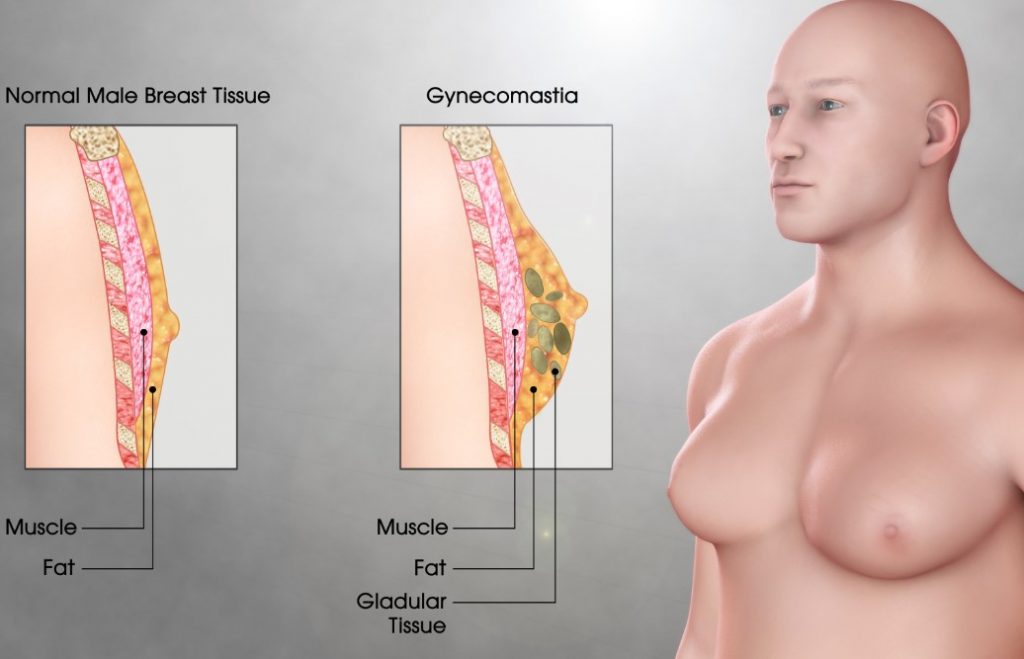Gynecomastia is a disorder when the male breast tissue gets bigger. Understanding symptoms to differentiate gynecomastia from pseudogynecomastia helps to figure out the right treatment choices. In the following article, we will look deeply into the details of the gynecomastia pinch test, a straightforward but powerful way to diagnose this condition.
Starting from understanding the basic nature of the disorder to understanding complexities in pinch tests – we aim to cover all aspects related to gynecomastia treatment. Gynecomastia can cause discomfort and distress both physically and emotionally so finding it early stages becomes very important.

The Definition and Reasons of Gynecomastia
In simple words, gynecomastia is an abnormal swelling of male breast tissue. According to the report posted by the National Center for Biotechnology Information, this condition occurs more frequently than most people might think, as it affects anywhere from 30% to 60% of men during certain times in their lives. The reasons behind gynecomastia can be different – from the changes in hormones to growing up, from the use of particular drugs to certain health issues.
From a physiological point of view, gynecomastia happens because there is an unbalance between two hormones: estrogen and testosterone. This hormonal shift results in the multiplication of glandular tissue within male breasts and then leads to their enlargement. Even though all male bodies typically produce a small quantity of estrogen, having too much compared to testosterone can result in noticeable changes within breast tissue.
Such hormonal imbalances might be a result of puberty, getting older, and certain medical treatments. Some medications like anti-androgens, anabolic steroids, and specific antidepressants can also cause the development of gynecomastia.
Also, serious health problems such as liver disease, kidney failure, or hyperthyroidism could be the reason for the development of this disorder.
To detect and eliminate the exact cause of gynecomastia it is very important to treat this disorder correctly. Only a healthcare provider can define the treatment course that usually involves the modification of lifestyle habits, diet, and the use of certain medications. In some cases, a doctor may recommend or insist on a breast reduction surgery to remove the extra fat tissue from the male breasts.
What Is The Pinch Test for Gynecomastia ?
But before defining the treatment course, it is vital to diagnose this disorder correctly. The pinch test for gynecomastia is a simple, non-invasive method that helps to differentiate true gynecomastia from pseudogynecomastia. This test involves pinching the tissue around the nipple and checking if it feels more like glandular tissue or fatty tissue.
The main goal of the gyno pinch test is to find out the cause of breast enlargement. It may happen because of too much glandular tissue and it is a first sign of gynecomastia. Otherwise, it can be just fat tissues meaning a man has pseudogynecomastia. Doctors need to understand the exact diagnosis to choose the appropriate treatment plan.
To do the first stage gynecomastia pinch test at home you can follow such steps, though it is better to go to a professional healthcare provider:
- Stand in front of a mirror to get a clear view of your chest;
- Take your thumb and forefinger to softly squeeze the skin near the areola, which is the darker region encompassing the nipple;
- Touch a firm piece of tissue, like the rubbery disk under your nipple. This is the glandular tissue that can reveal the first signs of developing gynecomastia;
- If the area feels like soft, pliable fat without any hard spots, then it’s probably pseudogynecomastia;
You can use the results from the gyno pinch test to help you decide what to do next. If you identify the glandular tissue, it could be a sign of gynecomastia. You might want to speak with your doctor for more professional scanning and talk about your treatment choices like medications, changes in lifestyle, or even the necessity of surgery. If you identify only fat and soft tissues, losing weight and doing exercise can help reduce breast size naturally.
How Does Early Stage Gynecomastia Pinch Test Help To Define Pseudogynecomastia?
It is very important to distinguish between pseudogynecomastia and real gynecomastia conditions at the early stages to define the proper treatment as soon as possible. Even if both conditions have the symptoms of breast enlargement in males, their causes and features are quite different.
As we said above, the visual sign when there’s too much fat but the glandular tissue remains intact characterizes pseudogynecomastia. Commonly linked with obesity, this disorder is easy to improve by losing weight and doing exercise.
Real gynecomastia is a more dangerous disorder that requires professional healthcare assistance. If you read any feedback about your personal experience with the gynecomastia pinch test on Reddit or any other social media, you will notice the same trend. All the people who have been diagnosed with real gynecomastia also had hormonal imbalances since their teenage years.
When doing the pseudogynecomastia gynecomastia pinch test, it is important to remember the corresponding condition called lipoma. According to another report posted by the National Library of Medicine, this harmless fat tumor along with the serious condition breast cancer and mastitis (a.k.a. breast inflammation) have the same symptoms as real or pseudogynecomastia. That is why you can’t just stop at self-diagnosis – if you have enlarged male breast tissues, consider visiting a healthcare provider as soon as possible.
Other Methods to Detect the Early Stages of Gynecomastia
Besides, the above-mentioned gynecomastia pinch test, healthcare providers use such screening methods as imaging studies, mammography, ultrasound, and MRI. These methods are quite effective when it comes to differentiating between fatty and glandular tissues, locating possible tumors, and evaluating the stage of the enlarged breast tissue.
These techniques along with the complex fat gynecomastia pinch test help to solve the situations when there is not enough doing just the physical testing.
How to Choose The Proper Gynecomastia Treatment Options?
It depends on the severity of gynecomastia in every individual case:
- The conservative methods help to treat the cases with light or medium severity;
- The breast reduction surgery is recommended only in severe, neglected cases;
- The use of pharmacological therapy (like Tamoxifen and Anastrozole) won’t help to solve the severe cases but can assist during the preparation stage before surgery;
Personal comfort and aesthetic goals are important when a patient chooses the treatment method for “man boobs”. Discussing with a plastic surgeon can give ideas about the best choices that match individual needs.
In most cases, the treatment of gynecomastia begins with non-invasive methods like lifestyle changes and medicinal therapy. It can progress to surgical methods such as liposuction or mastectomy. The diagnosis of this condition at an early stage, along with specific treatment strategies tailored for each patient, is a crucial factor in achieving successful therapy.
Psychological Impact of Gynecomastia
Even though gynecomastia is a physical condition this disorder can cause a deep psychological impact on men. The increased male breast tissue often results in emotional discomfort and problems with self-confidence that greatly affect mental health.
Men who have gynecomastia often feel ashamed and sensitive about how they look. This might affect their self-image, causing a low sense of worth and impacting interactions in daily life as well as intimate relationships. The emotional impact can be also intense during the teenage years when body image and self-awareness are forming.
In all these cases, the emotional support of family and friends is very important. Also, professional therapy can provide techniques to handle stress better, improve self-confidence, and encourage a healthier view of the affected man’s body. Moreover, it is also helpful to participate in support groups where people exchange their personal stories and ways of handling this disorder.
Preventing and managing gynecomastia includes a mix of steps to stop it from happening as well as ongoing methods. Following a reliable health routine, having frequent medical check-ups, and dealing with its root causes are important parts of preventing this condition.
Conclusion
Getting an appropriate medical treatment for gynecomastia is essential to manage this disorder effectively and enhance the person’s life quality. Setting up the correct diagnosis that defines the differences between true gynecomastia and pseudogynecomastia is vital for building personalized treatment strategies for each patient individually.
The gynecomastia pinch test is required to help in this sensitive diagnostics. It is highly recommended to visit the healthcare provider for the proper testing and treatment in the case of an enlarged male breast.


